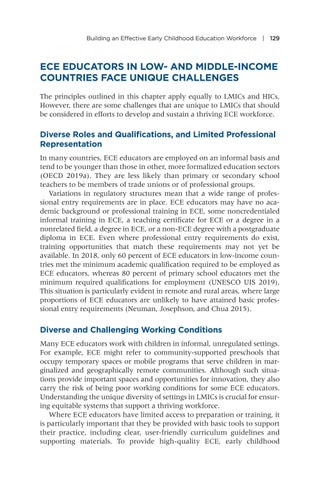Building an Effective Early Childhood Education Workforce | 129
ECE EDUCATORS IN LOW- AND MIDDLE-INCOME COUNTRIES FACE UNIQUE CHALLENGES The principles outlined in this chapter apply equally to LMICs and HICs. However, there are some challenges that are unique to LMICs that should be considered in efforts to develop and sustain a thriving ECE workforce.
Diverse Roles and Qualifications, and Limited Professional Representation In many countries, ECE educators are employed on an informal basis and tend to be younger than those in other, more formalized education sectors (OECD 2019a). They are less likely than primary or secondary school teachers to be members of trade unions or of professional groups. Variations in regulatory structures mean that a wide range of professional entry requirements are in place. ECE educators may have no academic background or professional training in ECE, some noncredentialed informal training in ECE, a teaching certificate for ECE or a degree in a nonrelated field, a degree in ECE, or a non-ECE degree with a postgraduate diploma in ECE. Even where professional entry requirements do exist, training opportunities that match these requirements may not yet be available. In 2018, only 60 percent of ECE educators in low-income countries met the minimum academic qualification required to be employed as ECE educators, whereas 80 percent of primary school educators met the minimum required qualifications for employment (UNESCO UIS 2019). This situation is particularly evident in remote and rural areas, where large proportions of ECE educators are unlikely to have attained basic professional entry requirements (Neuman, Josephson, and Chua 2015).
Diverse and Challenging Working Conditions Many ECE educators work with children in informal, unregulated settings. For example, ECE might refer to community-supported preschools that occupy temporary spaces or mobile programs that serve children in marginalized and geographically remote communities. Although such situations provide important spaces and opportunities for innovation, they also carry the risk of being poor working conditions for some ECE educators. Understanding the unique diversity of settings in LMICs is crucial for ensuring equitable systems that support a thriving workforce. Where ECE educators have limited access to preparation or training, it is particularly important that they be provided with basic tools to support their practice, including clear, user-friendly curriculum guidelines and supporting materials. To provide high-quality ECE, early childhood




